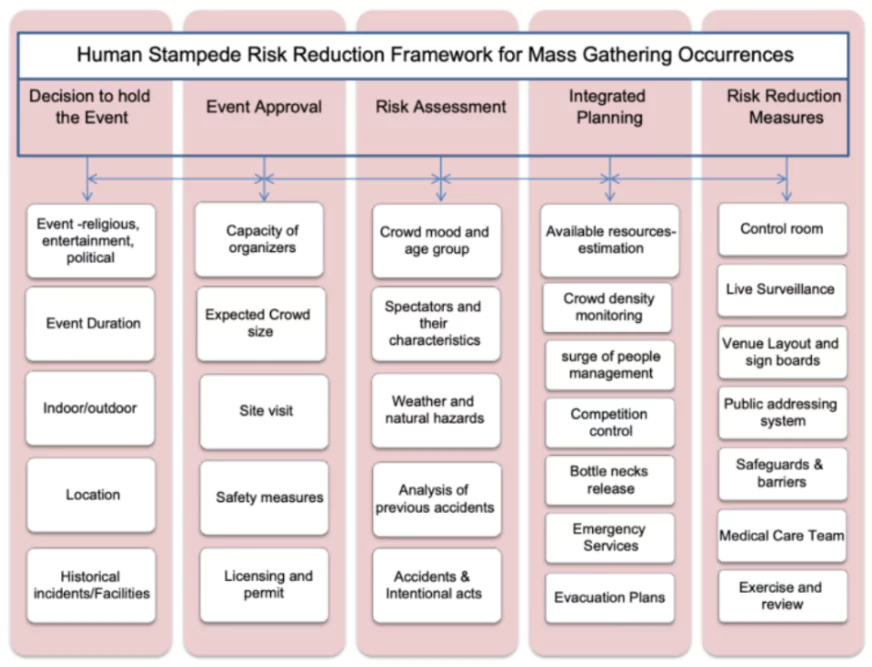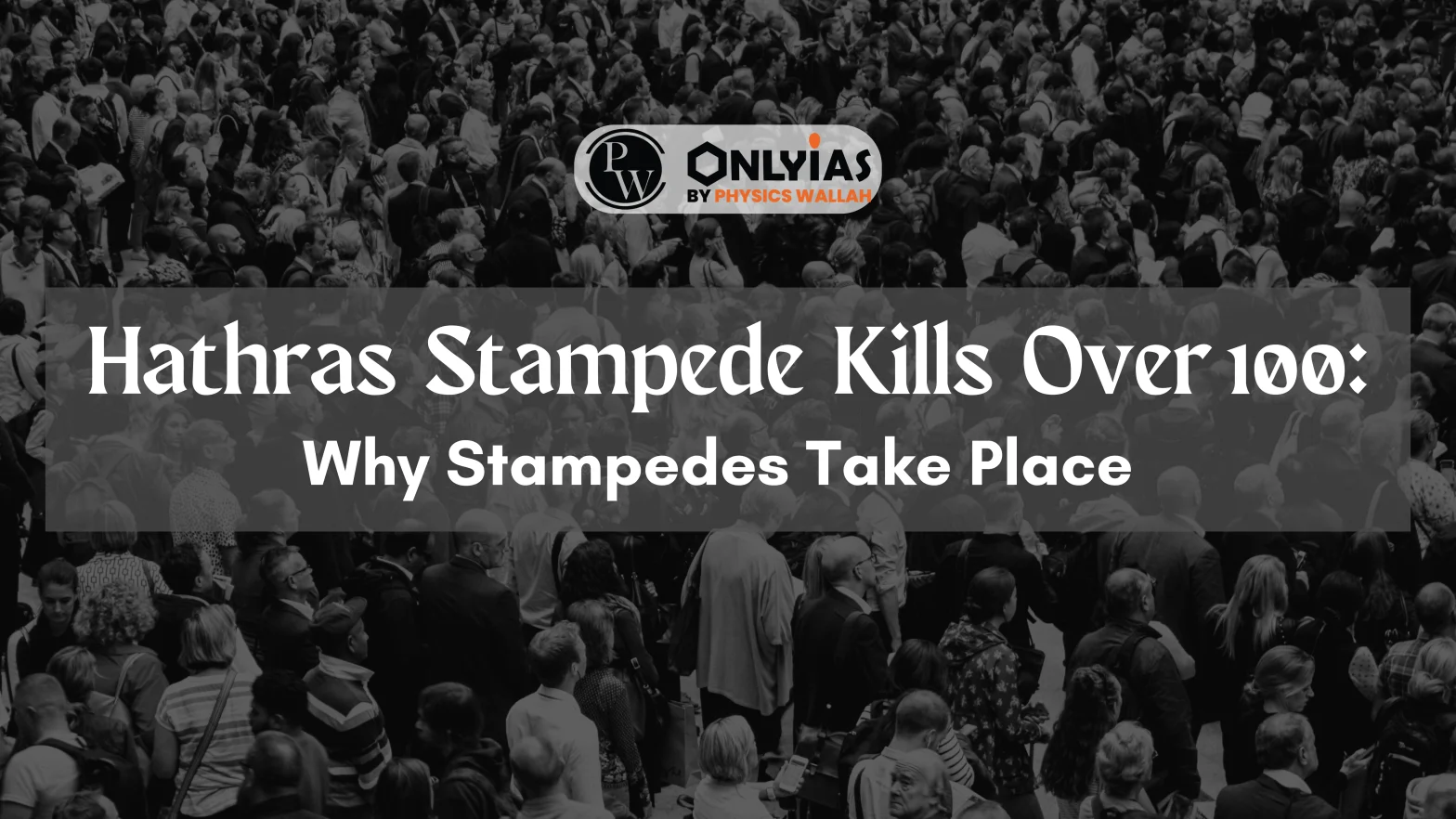From overcrowding and poor planning, to human psychology, many factors may lie behind deadly stampedes.
| Relevancy for Mains: Stampedes pose threat to public safety, Socio-economic, psychological, and administrative factors contributing to stampedes, etc. |
Tragic Stampede Incident
- Around 121 people, mostly women, killed in Hathras district, Uttar Pradesh. The incident occurred during a religious gathering.
- It is not the first fatal stampede at a religious gathering in India.
- 79% of all stampedes in India from 1954-2012 occurred during religious mass gatherings according to the “Human stampedes during religious festivals: A comparative review of mass gathering emergencies in India”
Enroll now for UPSC Online Course
Definition of a Stampede
- Defined by Wenguo Weng and others as “an impulsive mass movement of a crowd that often results in injuries and deaths”.
- Illiyas and others describe it as the “disruption of the orderly movement of crowds… leading to injuries and fatalities”.
- Often occurs in response to perceived danger, loss of physical space, or a desire to attain something gratifying
Causes of Stampede Casualties
- Traumatic Asphyxia: Most common cause of death is the partial or complete cessation of respiration due to external compression of the thorax and/or upper abdomen.
- Can occur even in moderate crowds of six to seven people pushing in one direction.
- Other Causes:
- Myocardial infarction (heart attack).
- Direct crushing injury to internal organs.
- Head injuries.
- Neck compression.
Human Psychology and Stampedes
- Mass Gatherings: Typically occur during mass gatherings, both spontaneous (e.g., metro stations) and planned (e.g., religious events).
- Panic: Panic triggers or exacerbates stampedes. Psychologist Alexander Mintz (1952) theorized that cooperative behavior is needed for success in panic-producing situations.
- Once cooperation is disturbed, pushing becomes the least disadvantageous behavior for individuals, leading to disastrous outcomes for the group.
- Craze: Sociologist Neil J. Smelser (1962) defined “craze” as the mobilisation for action based on a positive wish-fulfillment belief.
- This belief, whether rational or irrational, spreads in large groups and can lead to actions detrimental to individual interests
- Example from Hathras: According to Uttar Pradesh Chief Secretary, people rushed to touch the preacher’s feet and collect soil from where he walked, leading to the stampede
- Contribution of Physical Organization to Stampedes: Psychology of mass behavior is not the only factor behind stampedes. Better design of spaces for mass gatherings can prevent many stampedes. Improved design can help prevent panic from setting in.
Check Out UPSC CSE Books From PW Store
Factors Contributing to Stampedes (Chun-Hao Shao et al., 2018)
- Lack of light.
- Undivided crowd flow.
- Collapse of barriers or buildings.
- Blocked exits and evacuation routes.
- Poor design of hardware (e.g., revolving doors at entrances).
- Fire hazards.
- Importance of Crowd Density
- Crowd density should influence space design for mass gatherings.
- High density increases evacuation time and panic risk.
Types of Stampedes (K.M. Ngai et al., 2009)
- Unidirectional Stampedes: Occur when crowd moving in one direction faces sudden force changes.
- Positive force: Sudden stop situations (e.g., bottlenecks, blocked exits).
- Negative force: Broken barriers or columns causing people to tumble.
- Turbulent Stampedes: Occur in uncontrolled crowd situations. Induced panic or merging crowds from different directions.
Preventing and Mitigating Stampedes
- Controlled Entry: Ideally, limit the number of people entering a contained space.
- Critical Measures:
- Number and Placement of Exits: Essential for safe evacuation.
- Event Organisers’ Vigilance: Continuous monitoring and real-time interventions.
- Planning and Mitigation: Identify potential hazards. Design and execute appropriate mitigation measures.
- Stampede Risk-Reduction Framework: Live surveillance of the crowd. Monitor pressure buildup, crowd density, bottlenecks. Identify sources of crowd disturbance. Manage and control crowds effectively.
- Importance of Communication: Between Organisers and with the Crowd. Coordination among temple authorities, local administration, and police.

Notable Deadly Stampedes
- Moscow, Russia (1896): One of the first documented human crowd disasters. Occurred on the eve of Russian Tsar Nicholas II’s coronation ceremony. Over 1,000 people crushed or trampled to death. Triggered by rumors of souvenir shortages.
- Allahabad, India (1954): Most fatal Kumbh Mela stampede in history. Lack of crowd control, poor planning, and excessive VIP presence. Triggered by a crowd surge breaking through barriers. Approximately 800 deaths. Lessons from this tragedy are foundational for managing the Kumbh Mela.
- Lima, Peru (1963): Fans incensed at a referee’s decision during a Peru-Argentina match. Police fired tear gas into grandstands, causing mass panic. Escaping spectators crushed in enclosed stairways blocked with solid gates.
- Wai, India (2005): Annual pilgrimage at Mandhardevi temple, Maharashtra. Over 340 people trampled to death, hundreds injured. Triggered when people fell on slippery steps due to broken coconuts.
- Mina, Saudi Arabia (2015): Deadly stampede during Hajj pilgrimage. Two large groups of pilgrims intersected on the same street.
Enroll now for UPSC Online Classes
Conclusion
Effective crowd management, better space design, and vigilant monitoring are essential to prevent stampedes and ensure safety at mass gatherings, particularly during religious events.
![]() 3 Jul 2024
3 Jul 2024


